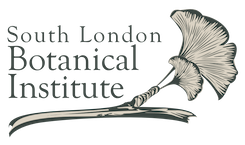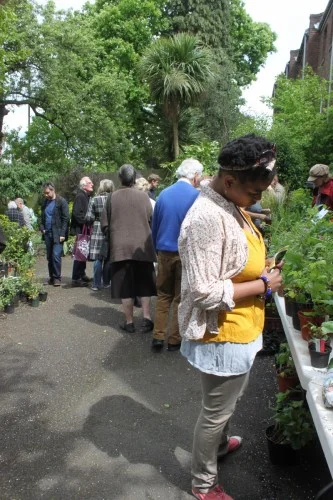The SLBI provides facilities for the study of plants, including ecology and conservation, and aims to encourage interest in all aspects of plant life. We encourage people from all ages, backgrounds and different levels of learning.
Since its inception in 1910, the Institute has enabled many to develop a satisfying and absorbing interest, become better botanists, pursue their own studies, share their knowledge with like-minded individuals and contribute to our natural heritage.
The early history of the SLBI
Founded in 1910 by a keen botanist, Allan Octavian Hume (1829-1912), the aims of the Institute have remained almost unchanged in 100 years. Hume’s lasting contribution has been to provide an environment where those interested in plants, whether they are amateur or professional, may meet and develop their knowledge of plants.
Several generations of botanists have benefited from, and contributed to, the facilities available at the Institute. Today, members still enjoy evening lectures, field trips, workshops, the library, garden and herbaria (dried plant collections).
Originally a civil servant, Hume spent 45 years serving the people of India in a most progressive and forward-thinking manner: he realised that India’s development and release from poverty depended on agricultural reforms. After his retirement, he initiated the creation of the Indian National Congress in the call for Indian independence.
A leading ornithologist in India, after his return to England in 1894, Hume turned his attention to horticulture, embarking on an intensive study of British flora, employing W.H. Griffin as his botanical assistant in 1901. His intention was to make the study of plants accessible to the working classes: he recognised the difficulty in identifying alien plant species and began growing and pressing for a herbarium.
This interest led him to purchase in a Victorian house in Tulse Hill in 1909, which a year later became the South London Botanical Institute. At the heart of the early library and herbarium were the books and specimens of Hume, F. H. Davey, W. H. Beeby, F. Townsend and J. Woods.
Over the years, many distinguished botanists have been associated with the Institute, notably W. R. Sherrin, Dr John Ramsbottom, J.E. Lousley and Dr Cecil Prime.
See our films about our founder:
Enjoy an episode of BBC Radio 4’s Gardeners’ Question Time, in which Matt Biggs interviews Roy Moxham about Hume’s work on the Great Hedge of India.
About the SLBI today
Today the SLBI continues to base its activities on the aims of Hume. We have developed a new business plan covering 2021-2026 which can be found here.
The SLBI is made up of a small team of five members of staff and lots of greatly valued volunteers. A small Board of Trustees lead the SLBI, and Dr Maria (bat), Research Leader at Kew Gardens, is the President of the SLBI. See details of our Trustees here.
If you would like to become a trustee or volunteer in another way, please see Get Involved.
Climate change emergency
The SLBI has joined organisations around London, and the world, in declaring a climate emergency. The announcement was made following a meeting of the SLBI’s Board of Trustees on Thursday 6 February 2020.
In line with the SLBI’s charitable objects, the organisation has always been committed to sustainable development (meeting the needs of the present without compromising the ability of future generations to meet their own needs) as a guiding principle within its work.
Concern for the environment at this time of climate emergency, including reducing the charity’s carbon footprint and educating others in what they can do to help, is an integral and fundamental part of this commitment.
Like many other environmental and educational organisations (as well as health organisations and local authorities) who have already declared a climate emergency, the SLBI recognises that climate change is the critical issue of our time and needs urgent action. The science behind the issue has been well-documented, including the need to reverse carbon emissions drastically over the next 10 years.
The SLBI aims to hold events based around the climate emergency. These have included lectures, workshops, walks and school visits highlighting different aspects of climate change and how these impact on the plant world and therefore on humans as a species. Events will also demonstrate the vital importance of plants in combatting climate change. All these activities aim to encourage behaviour change in visiting individuals, schools, families and other organisations.
See more about the SLBI’s climate change emergency declaration.
View our reports, policies and values statements
Memorandum and Articles of Association
2021-2022: Year In Numbers
Accounts 2021-2022
Accounts 2020-2021
Accounts 2019-2020
Accounts 2018-2019
Accounts 2017-2018
Impact Report 2020-2021
SLBI Complaints Policy
SLBI Conflict of interest policy
SLBI Equality and diversity policy
SLBI Environmental policy
SLBI Ethical Funding Policy
SLBI Health and Safety Policy
SLBI Invasive Plants Policy 2022
SLBI Investment policy 2023
SLBI Maternity leave and pay policy
SLBI Safeguarding Policy
SLBI Staff Disciplinary and Grievance Procedures
SLBI Volunteering Policy
SLBI Business Plan 2021-2026 Executive Summary
SLBI Climate Emergency Declaration
SLBI Black Lives Matter statement

